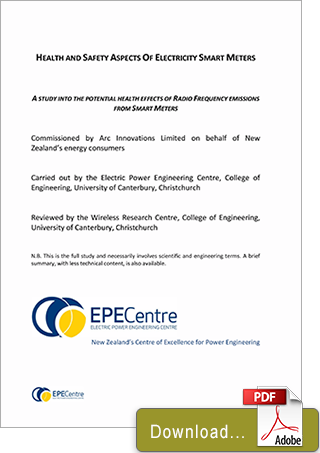 Health and safety aspects of electricity advanced meters
Health and safety aspects of electricity advanced meters
A study into the potential health effects of radio frequency emissions from advanced meters
Commissioned by Arc Innovations Limited on behalf of New Zealand’s energy consumers. Carried out by the Electric Power Engineering Centre, College of Engineering, University of Canterbury, Christchurch. Reviewed by the Wireless Research Centre, College of Engineering, University of Canterbury, Christchurch.
- View the brief study
- View the full study
Information in this study:
Introduction to advanced meters
Why the industry wants advanced meters
Why advanced meters are good for the customer and nz inc
Potential health concerns over advanced meters
Potential health effects of wireless rf transmission
Basics of the electromagnetic spectrum
Ionizing versus non-ionizing radiation
Standards for safe exposure to non-ionizing radiation
Rf emissions of advanced meters
Propagation of rf fields
Antennas and gain
Reflections
Obtaining figures for s from advanced meter transmitters
Worst-case calculations
Comparison of rf levels between advanced meters and other sources
Other studies
Summary and conclusions
References
- New Zealand’s Centre of Excellence for Power Engineering
Introduction to advanced meters
“advanced meter” is a term coined to describe the new electronic electricity meters that are rapidly replacing old electromechanical meters. They are also becoming increasingly referred to as “Advanced Meters”.
These new meters incorporate electronic circuitry that accurately calculates power usage (kW) in order to add up the total energy usage (kWh – the “units” shown on the electricity bill). In addition advanced meters may be capable of many more functions, such as:
- “Time of use metering” – recording when, as well as how much, energy has been used
- Measuring voltage amplitude and quality – recording fluctuations and distortion of the nominal 230V, 50Hz waveform
- Switching of large loads (e.g. hot water heater) in response to system signals (function already carried out on older installations using separate ripple control relay)
- Networking with “Smart” appliances inside the house – e.g. potential to turn on tumble dryer when electricity demand/price is lowest
In order to make best use of these capabilities, the advanced meters need to be able to communicate some or all of their measurements to the electricity companies for billing and other purposes, and also to receive commands from the electricity company for set-up and load control purposes.
Hence at least one communication channel is necessary between the meter and some remote collection/control point. There are a number of possibilities for such channels, including:
- Power Line Carrier (PLC) – data signals are superimposed on the power line itself
- Wireless Radio Frequency (RF) – data signals are transmitted and received by radio
- Ethernet/Broadband – data signals are sent over the broadband data/telephone network (usually copper or optic fibre)
Why the industry wants advanced meters
As discussed above, some meters are smarter than others, depending what capabilities they have, or can be upgraded to incorporate. In the simplest case they replace the meter reader by sending the monthly reading electronically. This is known as Automatic Meter Reading (AMR). This has the obvious benefits of saving staff and transport costs, eliminating reading errors and the need to estimate bills when the meter cannot be reached.
Advanced Metering Infrastructure (AMI) is a much more significant concept, requiring the smarter advanced meters with the extra functionality. With this infrastructure in place the electricity companies have the potential to match demand and available supply, for instance by:
- disconnecting non-essential devices when demand is exceeding supply
- bringing Distributed Generation (DG) sources (such as small wind farms and solar generators) online when demand is exceeding supply
- sending real-time pricing signals to encourage/enable customers to run the tumble dryer or recharge the Electric Vehicle (EV) when there is excess supply available
The above concepts are often known as Demand Management (DM), or Demand-side Management (DSM).
Why advanced meters are good for the customer and NZ Inc
At present load demand is very ‘peaky’. That is, the peak electricity usage is very much higher than the average. This requires having the capacity in generators, transmission lines and distribution equipment to meet the peak. As the peak increases, so does the need for new generation, transmission lines and distribution systems.
With much more detailed information available regarding the time when individual households, and potentially even when individual appliances, are using power, users have the opportunity to be much more circumspect about their consumption of electricity. It is already possible for many customers with advanced meters to keep continuous tabs on their electricity usage via the internet. With pricing based on available supply versus demand, there are opportunities for saving money when using large amounts of energy (tumble drying, EV charging, water heating). With controllable loads also connected (very likely in the case of EV charging), demand can be shaped to avoid building new infrastructure, thus keeping costs and environmental concerns under control.
This is a real chance for the industry and customers alike to change the pattern of consumption to maximize use of renewable energy (e.g. solar, wind and hydro), whilst minimizing use of fossil fuels and overall energy, and reducing the need for extremely expensive and unpopular grid upgrades, such as new transmission lines.
Potential health concerns over advanced meters
As with any new technology there are always potential concerns as to whether there are any health downsides that may have been overlooked. In the case of advanced meters there is valid concern for a close look when the communications medium is radio. This is because Radio Frequency (RF) waves cause heating of any body that absorbs power from them, depending on their frequency and intensity. (This heating effect is used deliberately in Microwave ovens).
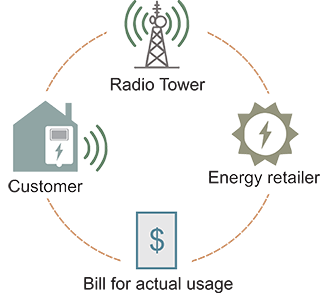
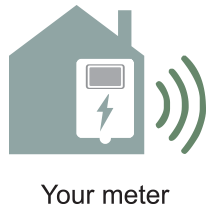
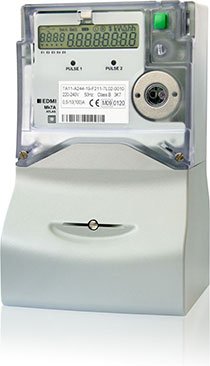
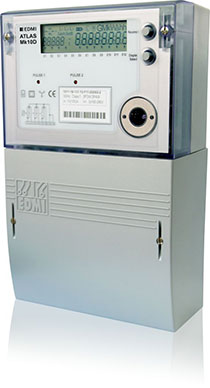 Mk10D
Mk10D